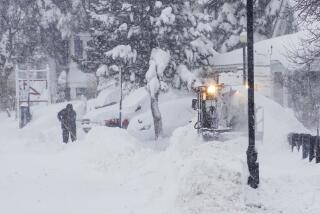California ski resorts slog through a warm winter
While the East Coast braces for another series of frigid storms, California ski resort operators are cursing Mother Nature for a winter of unseasonably warm temperatures and persistent blue skies.
California’s driest year on record has dropped snowpack levels to about 15% of the season average and reduced skier visitation numbers as much as 45%, compared with last year.
To draw skiers and snowboarders to the slopes, some resorts are offering two-for-one ticket deals and $1 beers.
“It’s been a strange winter,” said Chris Riddle, a spokesman for Bear Mountain and Snow Summit in the San Bernardino Mountains, where visitation numbers are off by about 15%.
Snowpack measurements taken last month were the lowest for that date in nearly half a century of record keeping, prompting Gov. Jerry Brown to declare a state drought emergency and call on all Californians to cut water use by 20%.
Still, many ski resort operators in California are not ready to call the season a bust. Storms in the last week have dropped more than a foot of snow on several California resorts, offering hope that more flurries this spring could turn things around.
“If you have the product, people will come,” said Bob Roberts, executive director of the California Ski Industry Assn., the trade group for the state’s 27 ski resorts.
Extreme weather has become the norm in the West.
At the end of the 2010-11 winter, the snowpack on the Sierra Nevada measured 165% of normal levels. But the following winter marked the lowest national average snowfall in 20 years, forcing half of the nation’s resorts to either open late or close early.
To protect California’s $3-billion ski industry from such extremes, resorts throughout the state have invested heavily in snow-making machines to keep the runs covered in white when the weather won’t cooperate.
The managers of the Snow Summit and Bear Mountain resorts in the San Bernardino Mountains have invested about $15 million in new snow-making equipment over the last decade. They said that’s enough to keep about 80% of the runs open on the two mountains this winter.
“We’re making the best of a tough situation,” Riddle said.
Squaw Valley and Alpine Meadows have spent a combined $5.2 million on snow-making equipment in the last two years.
Skiers say they prefer natural snow but will strap on their skis for the man-made stuff.
“The natural snow is what we strive for but we are going to take what Mother Nature gives us,” said professional skier Timy Dutton, who trains primarily at Squaw Valley. “It’s still super fun out there.”
Ski resorts have also turned to discounts and special deals this winter to entice skiers to the mountains.
Squaw Valley and Alpine Meadows introduced an $85 discount for two daily passes this season, plus free admission to concerts, $1 beers, and free snow tubing for annual pass holders.
“The skiing was really good but it was a little more limited than it normally was,” said Amelia Richmond, a spokeswoman for the two resorts.
Mammoth Mountain, the most popular resort for Southern California skiers, typically draws an estimated 1.4 million skiers annually. But skier visits are off by about 25% so far this year.
The resort has received only about 66 inches of snow. And the dry conditions forced Mammoth Mountain Chief Executive Rusty Gregory to impose a 25% pay cut for the resort’s 400 year-round employees through February.
“Our snow-making crews are working incredibly hard,” he said. “But the bottom line is this: Mother Nature owns the place and we just rent it.”
For some skiers, man-made snow is not enough.
Jonathan Carmel, 28, a longtime skier from Beverly Hills, said he was disappointed during a recent trip to Mammoth Mountain to find that the most challenging runs were closed because of lack of snow.
“All the primary runs were open, but for the rest, skiing doesn’t work on ice and rocks,” he said.
At Mammoth Outdoor Sports, manager Luke Wynen recently was renting out mountain bikes and directing customers to a network of nearby trails that are usually closed because of winter conditions.
He also promoted a snow park he built on a nearby vacant lot with a 30-foot-tall mountain of snow. But on balmy days, it was reduced to a melted heap half its original size and coated with dirt and oil in the middle of a large mud puddle.
“Now, it’s pretty sad,” Wynen said, inspecting the project originally intended to be a free fun zone that would trigger excitement and pull in revenue. “As soon as it snows, we’ll rebuild it.”







